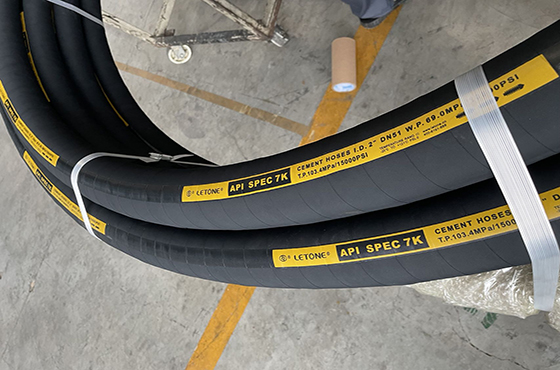Drilling hose
Drilling hose
Drilling hoses are high-pressure hoses used in drilling operations to transfer mud or other fluids from the drilling rig to the drill floor. They are essential components in the drilling process and play a critical role in ensuring the success of oil and gas exploration, mining, and tunneling operations.
Construction of Drilling Hose:
Drilling hoses have a complex construction that allows them to withstand the harsh conditions of drilling operations. The basic structure of a drilling hose consists of several layers of materials, including:
- Inner Tube: The inner tube is typically made from synthetic rubber, which is oil-resistant and heat-resistant. This layer is responsible for conveying the fluid through the hose.
- Reinforcement Layer: The reinforcement layer is made of multiple layers of high-strength steel wire braids or spirals, which provide the hose with its strength and flexibility.
- Cover: The cover is made of synthetic rubber or thermoplastic material, which protects the hose from external damage such as abrasion, ozone, and weathering.

Types of Drilling Hoses:
There are two main types of drilling hoses:
- Rotary Drilling Hose: This type of hose is used in rotary drilling operations, where the drilling rig rotates the drill string and bit while pumping mud or other fluids through the drilling hose. Rotary drilling hoses are designed to withstand high pressure and extreme temperatures.
- Vibrator Hose: This type of hose is used in vibration drilling operations, where the drill string vibrates to break up rock formations. Vibrator hoses are designed to withstand the high-frequency vibrations and shock loads generated during drilling operations.
Advantages of Drilling Hose:
- High Pressure Capability: Drilling hoses can withstand high pressure and are designed to transfer fluids at high flow rates, making them suitable for use in drilling operations.
- Abrasion Resistance: The steel wire reinforcement layer provides the hose with high abrasion resistance, making it ideal for use in harsh operating conditions such as drilling and mining operations.
- Flexibility: Drilling hoses have excellent flexibility, which allows them to bend and twist without kinking or collapsing, making them easy to route and install.
- Temperature Range: Drilling hoses can operate in a wide range of temperatures, from -40°C to +121°C, making them suitable for use in extreme hot or cold environments.
- Long Service Life: Drilling hoses are designed for long service life, even under heavy use and harsh operating conditions.
Applications of Drilling Hose:
Drilling hoses are used in a variety of applications, including:
- Oil and Gas Exploration: Drilling hoses are essential components in oil and gas exploration, providing a safe and efficient means of transferring mud and other fluids to the drill floor.
- Mining Operations: Drilling hoses are used in mining operations to transfer water, hydraulic fluids, and other materials to various parts of the mining process.
- Tunneling: Drilling hoses are used in tunneling operations to transfer water, chemicals, and other materials to various parts of the tunneling process.
- Construction: Drilling hoses are used in construction operations such as foundation drilling, piling, and trenchless drilling.
In conclusion, drilling hoses are essential components in drilling operations, providing high pressure capability, abrasion resistance, flexibility, and long service life. When selecting a drilling hose, it is important to consider factors such as the type of reinforcement, temperature range, pressure rating, and application requirements. It is also essential to ensure that the hose meets industry standards and regulations for safety and performance.
Previous: Steel wire braided hydraulic hose Next: Wire Braided Hose AssemblyCategories
Recent Posts
- High-Temperature Steam Hoses: A Comprehensive Overview
- Steel wire spiral reinforced hose
- Wire Braided Hose Assembly
- Drilling hose
- Fiber reinforced hydraulic hose
Contact
- Name : John wang
- Position : Sales Manager
- Email : [email protected]
- Phone : (+86)16650911696
- whatsApp : +86 16650911696
